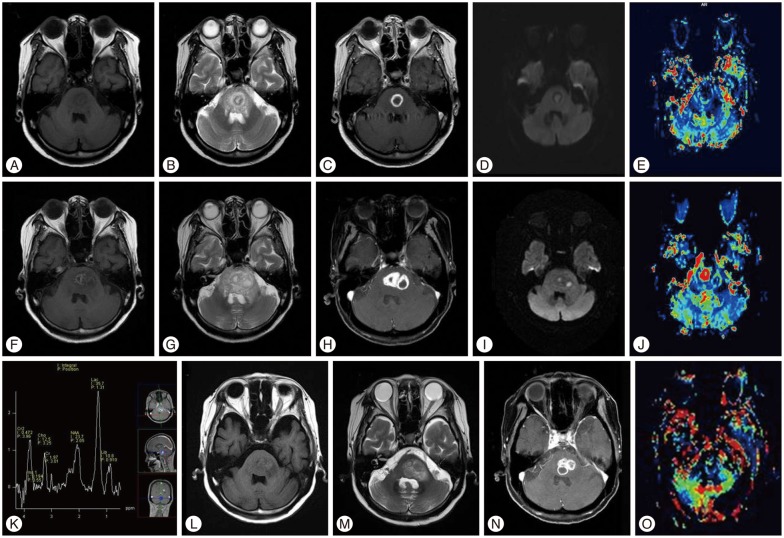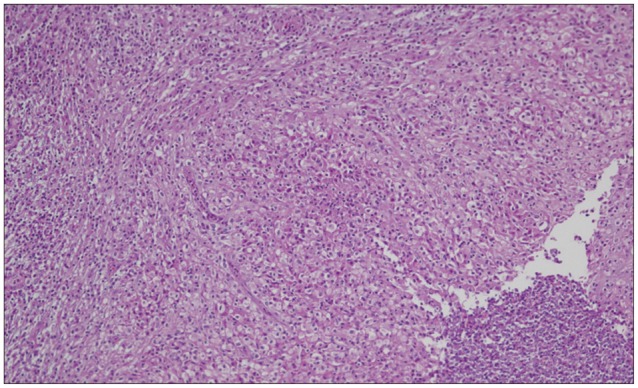J Korean Neurosurg Soc.
2015 Apr;57(4):307-310. 10.3340/jkns.2015.57.4.307.
Radiological Follow-up of a Cerebral Tuberculoma with a Paradoxical Response Mimicking a Brain Tumor
- Affiliations
-
- 1Department of Neurosurgery, Chonnam National University Research Institute of Medical Sciences, Chonnam National University Hwasun Hospital & Medical School, Gwangju, Korea. jung-ty@chonnam.ac.kr
- 2Department of Pathology, Chonnam National University Research Institute of Medical Sciences, Chonnam National University Hwasun Hospital & Medical School, Gwangju, Korea.
- 3Department of Radiology, Chonnam National University Research Institute of Medical Sciences, Chonnam National University Hwasun Hospital & Medical School, Gwangju, Korea.
- KMID: 1956433
- DOI: http://doi.org/10.3340/jkns.2015.57.4.307
Abstract
- We report a case of a paradoxical response of a tuberculoma in the brain mimicking a brain tumor. A 76-year-old woman presented with a 2 week history of headache, dysarthia, and orthopnea. Brain magnetic resonance images (MRI) revealed two rim-enhancing lesions on the pons and occipital lobe, and chest computed tomography showed randomly distributed miliary nodules. The tentative diagnosis was tuberculosis (TB) of the brain and lung. She complained of right hemiparesis and worsening general weakness after taking the anti-TB medication. On the monthly follow-up images, the enhanced lesions were enlarged with increased perfusion and choline/creatinine ratio, suggesting a high grade glioma. A surgical resection was completed to diagnose the occipital lesion, and the tuberculoma was pathologically confirmed by a positive TB-polymerase chain reaction. The anti-TB medication was continued for 13 months. A follow-up MRI showed decreased size of the brain lesions associated with perilesional edema, and the clinical symptoms had improved. Brain tuberculoma could be aggravated mimicking brain malignancy during administration of anti-TB medication. This paradoxical response can be effectively managed by continuing the anti-TB drugs.
Keyword
MeSH Terms
Figure
Reference
-
1. Afghani B, Lieberman JM. Paradoxical enlargement or development of intracranial tuberculomas during therapy : case report and review. Clin Infect Dis. 1994; 19:1092–1099. PMID: 7888539.
Article2. Álvarez-Salgado JA, Ruiz-Ginés JA, Fuentes-Ventura CD, Gonzales-Sejas AG, Belinchón de Diego JM, González-Llanos Fernández de Mesa F, et al. [Intracranial tuberculoma simulating a malignant tumor : case report and literature review]. Neurocirugia (Astur). 2011; 22:600–604. PMID: 22167292.3. Be NA, Kim KS, Bishai WR, Jain SK. Pathogenesis of central nervous system tuberculosis. Curr Mol Med. 2009; 9:94–99. PMID: 19275620.
Article4. Burman WJ, Jones BE. Treatment of HIV-related tuberculosis in the era of effective antiretroviral therapy. Am J Respir Crit Care Med. 2001; 164:7–12. PMID: 11435232.
Article5. Chambers ST, Hendrickse WA, Record C, Rudge P, Smith H. Paradoxical expansion of intracranial tuberculomas during chemotherapy. Lancet. 1984; 2:181–184. PMID: 6146749.
Article6. Cheng VC, Ho PL, Lee RA, Chan KS, Chan KK, Woo PC, et al. Clinical spectrum of paradoxical deterioration during antituberculosis therapy in non-HIV-infected patients. Eur J Clin Microbiol Infect Dis. 2002; 21:803–809. PMID: 12461590.
Article7. Cheng VC, Yam WC, Woo PC, Lau SK, Hung IF, Wong SP, et al. Risk factors for development of paradoxical response during antituberculosis therapy in HIV-negative patients. Eur J Clin Microbiol Infect Dis. 2003; 22:597–602. PMID: 14508660.
Article8. Coffey KC, Carroll VG, Steele RW. Ring-enhancing central nervous system lesions. Clin Pediatr (Phila). 2012; 51:1115–1118. PMID: 22669978.
Article9. Das A, Das SK, Mandal A, Halder AK. Cerebral tuberculoma as a manifestation of paradoxical reaction in patients with pulmonary and extrapulmonary tuberculosis. J Neurosci Rural Pract. 2012; 3:350–354. PMID: 23188994.
Article10. DeLance AR, Safaee M, Oh MC, Clark AJ, Kaur G, Sun MZ, et al. Tuberculoma of the central nervous system. J Clin Neurosci. 2013; 20:1333–1341. PMID: 23768968.
Article11. Garcia-Monco JC. Central nervous system tuberculosis. Neurol Clin. 1999; 17:737–759. PMID: 10517926.
Article12. Gupta RK, Kumar S. Central nervous system tuberculosis. Neuroimaging Clin N Am. 2011; 21:795–814. vii–viii. PMID: 22032500.
Article13. Kumar R. Atypical response to chemotherapy in neurotuberculosis. Br J Neurosurg. 1998; 12:344–348. PMID: 10070428.
Article14. Kumar V, Abbas AK, Fausto N, Mitchell RN. Robbins Basic Pathology, Eighth Edition. ed 8. Philadelphia, PA: Saunders/Elsevier;2007. p. 516–522.15. Malone JL, Paparello S, Rickman LS, Wagner KF, Monahan B, Oldfield EC. Intracranial tuberculoma developing during therapy for tuberculous meningitis. West J Med. 1990; 152:188–190. PMID: 2305578.16. Radmanesh F, Nejat F, El Khashab M. Cerebral infarction as the first presentation of tuberculosis in an infant : a case report. J Microbiol Immunol Infect. 2010; 43:249–252. PMID: 21291854.
Article
- Full Text Links
- Actions
-
Cited
- CITED
-
- Close
- Share
- Similar articles
-
- 10 Cases of Paradoxical Expansion of Intracranial Terculomas During Chemotherapy
- Paradoxical Deterioration of Intramedullary Spinal Tuberculomas during Antituberculous Therapy
- Balo's Concentric Sclerosis Mimicking Cerebral Tuberculoma
- Miliary Tuberculosis Mimicking Brain Metastasis from Renal Cell Carcinoma
- Paradoxical Response During Antituberculous Treatment for Abdominal Tuberculosis



